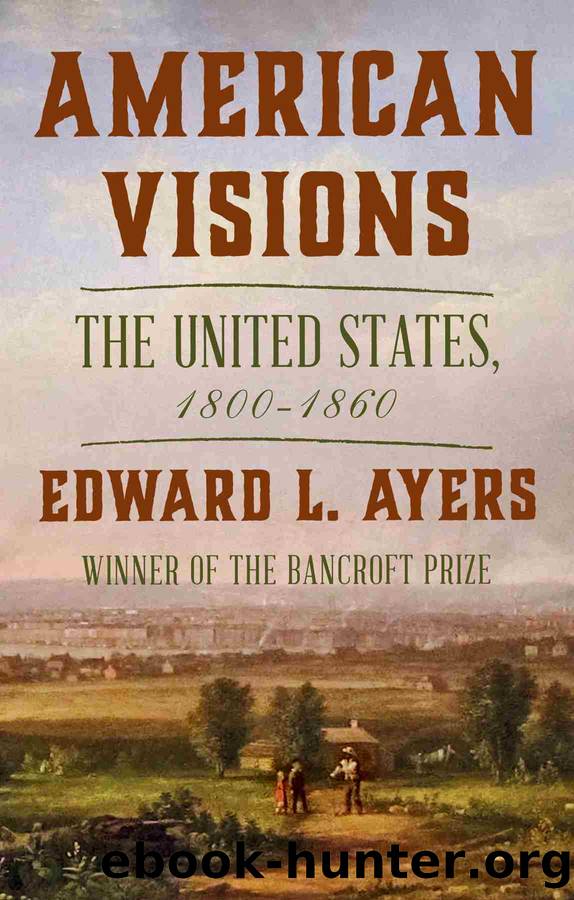American Visions by Edward L. Ayers

Author:Edward L. Ayers
Language: eng
Format: epub
Publisher: W. W. Norton & Company
Chapter Seven
VOYAGES
1845â1850
New Americans
More people moved to the United States between 1820 and 1860 than had lived in the country in 1790. The 150,000 immigrants of the 1820s grew to 600,000 in the 1830s to 1.4 million in the 1840s and then to 2.8 million in the 1850s, the pace of arrivals reaching its peak between 1845 and 1854.1
Tragedies in the potato fields of Ireland transformed lives on both sides of the Atlantic. The United States emerged as a refuge for millions of people starving in their beloved homeland. In July 1845, âthere was a cry around that some blight had struck the potato stalks.â The leaves blackened and then crumbled. Throughout Ireland, the very âair was laden with a sickly odor of decay, as if the hand of death had stricken the potato field, and ⦠everything growing in it was rotten.â Disease and even starvation afflicted the poorest people. Landlords removed hundreds of thousands of tenants from their lands to raise cattle and grain. As many as a million people died.2
More than 1.25 million Irish people left their homes over the next ten years. The Atlantic exodus began in 1846, doubled in 1847, briefly slowed and then reached a peak in 1851; it would not decline for another four years. Most emigrants gathered in Liverpool before heading to New York and Boston. They negotiated their moves with little assistance from the government or anyone else, surviving disease, neglect, and hunger on cramped and dirty ships. Those who had gone before offered advice and what financial help they could. ââWe hope that you will brace your nerves and steel your face and be nothing daunted and you will soon join with us on this Great Continent,â a friend wrote on the back of tickets sent to a family coming to the United States with four daughters. âThere will be dificultyes to meet with but then consider the object you have in view.â3
Once in the United States, Irish womenâwho accounted for most of the migrantsâworked as domestics. Men took whatever laboring jobs they could find. Those who arrived in winter found that construction work on railroads and canals in the Northeast slowed or stopped in the coldest months. The immigrants moved often, seeking comfort in the company of other Irish people. Their children had to go to work early in their lives and labor for long hours, missing education. Catholic churches were overwhelmed with need and numbers. The Irish organized clubs, fire companies, and charities. They recruited one another into labor unions and political clubs. Some native-born Americans offered help as well, though often tying their aid to efforts to convert Catholics to Protestantism. Male immigrants, eligible to vote soon after their arrival, found that the Democrats welcomed Irish voters into their ranks.4
Immigrants streamed to the United States from other places as well, for the potato famine assailed nearly all of Northern Europe. It afflicted the Low Countries and the Nordic countries; it ranged from Prussia into Spain and Portugal; landlords in Sweden and Germany paid tenants to leave.
Download
This site does not store any files on its server. We only index and link to content provided by other sites. Please contact the content providers to delete copyright contents if any and email us, we'll remove relevant links or contents immediately.
4 3 2 1: A Novel by Paul Auster(12290)
The handmaid's tale by Margaret Atwood(7685)
Giovanni's Room by James Baldwin(7201)
Asking the Right Questions: A Guide to Critical Thinking by M. Neil Browne & Stuart M. Keeley(5664)
Big Magic: Creative Living Beyond Fear by Elizabeth Gilbert(5618)
Ego Is the Enemy by Ryan Holiday(5298)
The Body: A Guide for Occupants by Bill Bryson(4978)
On Writing A Memoir of the Craft by Stephen King(4866)
Ken Follett - World without end by Ken Follett(4648)
Adulting by Kelly Williams Brown(4491)
Bluets by Maggie Nelson(4480)
Eat That Frog! by Brian Tracy(4441)
Guilty Pleasures by Laurell K Hamilton(4363)
The Poetry of Pablo Neruda by Pablo Neruda(4042)
Alive: The Story of the Andes Survivors by Piers Paul Read(3970)
White Noise - A Novel by Don DeLillo(3957)
Fingerprints of the Gods by Graham Hancock(3943)
The Book of Joy by Dalai Lama(3904)
The Bookshop by Penelope Fitzgerald(3783)
